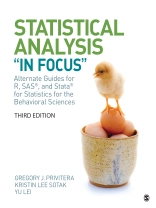Statistical Analysis ‘In Focus’ supports users of Gregory J. Privitera’s Statistics for the Behavioral Sciences, Third Edition who work with a statistical program other than SPSS or Excel. Three standalone parts, each dedicated to R, SAS, and Stata, serve as step-by-step guides for completing the ‘In Focus’ exercises in Privitera’s core text. A conversational writing style along with ‘To The Student’ introductions allow students to familiarize themselves and become more comfortable with each program prior to making computations. Additionally, General Instruction Guidebook (GIG) sections for R, SAS, and Stata provide standardized how-to instructions for using each program, making the book a valuable reference for students beyond their studies.
Table of Content
About the Authors
About This Supplemental Guide
PART I. ANALYSIS IN FOCUS: R
To the Student—How to Use R With This Book
R in Focus
1.7 Entering and Defining Variables (p. 23)
2.4 Frequency Distributions for Quantitative Data (p. 46)
2.7 Frequency Distributions for Categorical Data (p. 51)
2.12 Histograms, Bar Charts, and Pie Charts (p. 65)
3.6 Mean, Median, and Mode (p. 98)
4.11 Range, Variance, and Standard Deviation (p. 129)
5.6 Probability Tables (p. 152)
6.8 Converting Raw Scores to Standard z Scores (p. 193)
7.7 Estimating the Standard Error of the Mean (p. 227)
9.6 One-Sample t Test (p. 286)
9.9 Two-Independent-Sample t Test (p. 297)
10.4 The Related-Samples t Test (p. 317)
11.5 Confidence Intervals for the One-Sample t Test (p. 347)
11.7 Confidence Intervals for the Two-Independent-Sample t Test (p. 350)
11.9 Confidence Intervals for the Related-Samples t Test (p. 353)
12.8 The One-Way Between-Subjects ANOVA (p. 389)
13.6 The One-Way Within-Subjects ANOVA (p. 423)
14.8 The Two-Way Between-Subjects ANOVA (p. 474)
15.4 Pearson Correlation Coefficient (p. 501)
15.8 Spearman Correlation Coefficient (p. 512)
15.10 Point-Biserial Correlation Coefficient (p. 517)
15.12 Phi Correlation Coefficient (p. 522)
16.7 Analysis of Regression (p. 551)
16.13 Multiple Regression Analysis (p. 566)
17.3 The Chi-Square Goodness-of-Fit Test (p. 586)
17.9 The Chi-Square Test for Independence (p. 601)
18.3 The Related-Samples Sign Test (p. 621)
18.5 The Wilcoxon Signed-Ranks T Test (p. 626)
18.7 The Mann-Whitney U Test (p. 632)
18.9 The Kruskal-Wallis H Test (p. 637)
18.11 The Friedman Test (p. 641)
General Instruction Guide
PART II. ANALYSIS IN FOCUS: SAS
To the Student—How to Use SAS With This Book
SAS in Focus
1.7 Entering and Defining Variables (p. 23)
2.4 Frequency Distributions for Quantitative Data (p. 46)
2.7 Frequency Distributions for Categorical Data (p. 51)
2.12 Histograms, Bar Charts, and Pie Charts (p. 65)
3.6 Mean, Median, and Mode (p. 98)
4.11 Range, Variance, and Standard Deviation (p. 129)
5.6 Probability Tables (p. 152)
6.8 Converting Raw Scores to Standard z Scores (p. 193)
7.7 Estimating the Standard Error of the Mean (p. 227)
9.6 One-Sample t Test (p. 286)
9.9 Two-Independent-Sample t Test (p. 297)
10.4 The Related-Samples t Test (p. 317)
11.5 Confidence Intervals for the One-Sample t Test (p. 347)
11.7 Confidence Intervals for the Two-Independent-Sample t Test (p. 350)
11.9 Confidence Intervals for the Related-Samples t Test (p. 353)
12.8 The One-Way Between-Subjects ANOVA (p. 389)
13.6 The One-Way Within-Subjects ANOVA (p. 423)
14.8 The Two-Way Between-Subjects ANOVA (p. 474)
15.4 Pearson Correlation Coefficient (p. 501)
15.8 Spearman Correlation Coefficient (p. 512)
15.10 Point-Biserial Correlation Coefficient (p. 517)
15.12 Phi Correlation Coefficient (p. 522)
16.7 Analysis of Regression (p. 551)
16.13 Multiple Regression Analysis (p. 566)
17.3 The Chi-Square Goodness-of-Fit Test (p. 586)
17.9 The Chi-Square Test for Independence (p. 601)
18.3 The Related-Samples Sign Test (p. 621)
18.5 The Wilcoxon Signed-Ranks T Test (p. 626)
18.7 The Mann-Whitney U Test (p. 632)
18.9 The Kruskal-Wallis H Test (p. 637)
18.11 The Friedman Test (p. 641)
General Instruction Guide
PART III. ANALYSIS IN FOCUS: STATA
To the Student—How to Use Stata With This Book
Stata in Focus
1.7 Entering and Defining Variables (p. 23)
2.4 Frequency Distributions for Quantitative Data (p. 46)
2.7 Frequency Distributions for Categorical Data (p. 51)
2.12 Histograms, Bar Charts, and Pie Charts (p. 65)
3.6 Mean, Median, and Mode (p. 98)
4.11 Range, Variance, and Standard Deviation (p. 129)
5.6 Probability Tables (p. 152)
6.8 Converting Raw Scores to Standard z Scores (p. 193)
7.7 Estimating the Standard Error of the Mean (p. 227)
9.6 One-Sample t Test (p. 286)
9.9 Two-Independent-Sample t Test (p. 297)
10.4 The Related-Samples t Test (p. 317)
11.5 Confidence Intervals for the One-Sample t Test (p. 347)
11.7 Confidence Intervals for the Two-Independent-Sample t Test (p. 350)
11.9 Confidence Intervals for the Related-Samples t Test (p. 353)
12.8 The One-Way Between-Subjects ANOVA (p. 389)
13.6 The One-Way Within-Subjects ANOVA (p. 423)
14.8 The Two-Way Between-Subjects ANOVA (p. 474)
15.4 Pearson Correlation Coefficient (p. 501)
15.8 Spearman Correlation Coefficient (p. 512)
15.10 Point-Biserial Correlation Coefficient (p. 517)
15.12 Phi Correlation Coefficient (p. 522)
16.7 Analysis of Regression (p. 551)
16.13 Multiple Regression Analysis (p. 566)
17.3 The Chi-Square Goodness-of-Fit Test (p. 586)
17.9 The Chi-Square Test for Independence (p. 601)
18.3 The Related-Samples Sign Test (p. 621)
18.5 The Wilcoxon Signed-Ranks T Test (p. 626)
18.7 The Mann-Whitney U Test (p. 632)
18.9 The Kruskal-Wallis H Test (p. 637)
18.11 The Friedman Test (p. 641)
General Instruction Guide
References
Index
About the author
Gregory J. Privitera is a professor of psychology at St. Bonaventure University where he is a recipient of its highest teaching honor, The Award for Professional Excellence in Teaching, and its highest honor for scholarship, The Award for Professional Excellence in Research and Publication. Dr. Privitera received his Ph D in behavioral neuroscience in the field of psychology at the State University of New York at Buffalo and continued with his postdoctoral research at Arizona State University. He is a nationally award-winning author and research scholar. His textbooks span across diverse topics in psychology and the behavioral sciences, including an introductory psychology text, four statistics texts, two research methods texts, and multiple other texts bridging knowledge creation across health, health care, and analytics. In addition, Dr. Privitera has authored more than three dozen peer-reviewed papers aimed at advancing our understanding of health and informing policy in health care. His research has earned recognition by the American Psychological Association, and in media to include Oprah’s Magazine, Time Magazine, and the Wall Street Journal. He mentors a variety of undergraduate research projects at St. Bonaventure University, where dozens of students, many of whom have gone on to earn graduate and doctoral degrees at various institutions, have coauthored and presented research work. In addition to his teaching, research, and advisement, Dr. Privitera is a veteran of the U.S. Marine Corps, is an identical twin, and is married with two daughters, Grace Ann and Charlotte Jane, and two sons, Aiden Andrew and Luca James.












